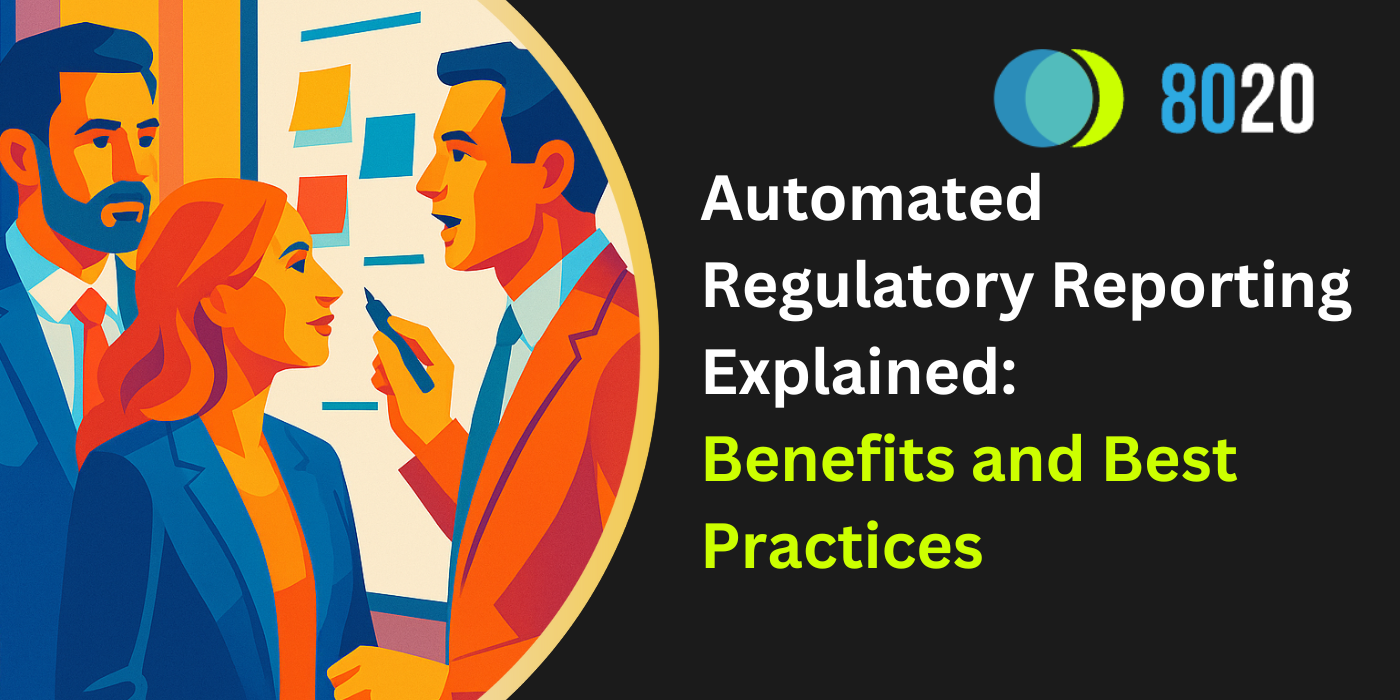As a financial consultant who has guided numerous organizations through their regulatory reporting transformations, I've witnessed firsthand the challenges that manual reporting processes create. The endless hours spent collecting data, the stress of looming deadlines, and the constant worry about potential errors – these are pain points that resonate with many finance leaders. In today's complex regulatory landscape, maintaining compliance while ensuring efficiency isn't just a goal; it's a necessity for survival.
Key Takeaways
|
Table of Contents
- What is Automated Regulatory Reporting?
- Business Benefits of Automated Regulatory Reporting
- Automated Regulatory Reporting Best Practices
- How to Get Started with Automated Regulatory Reporting
What is Automated Regulatory Reporting?
Automated regulatory reporting is a technology-driven approach that streamlines the collection, validation, and submission of required regulatory reports. It replaces manual, spreadsheet-based processes with sophisticated software systems that can automatically gather data from various sources, process it according to regulatory requirements, and generate accurate reports in the required formats.
In my experience working with various financial institutions, the shift to automated reporting represents more than just a technological upgrade – it's a fundamental transformation in how organizations approach compliance. According to the Financial Stability Board's report on regulatory technology, this transformation is becoming increasingly critical as regulatory requirements grow more complex.
Why do companies use automated regulatory reporting?
Organizations implement automated regulatory reporting primarily to address the growing complexity and volume of regulatory requirements while reducing the risk of non-compliance. In today's regulatory environment, where requirements from bodies like the SEC, FINRA, and international regulators are constantly evolving, manual processes simply can't keep up.
I recently worked with a mid-sized financial institution that was struggling with their quarterly reporting requirements. Before automation, their team spent nearly three weeks per quarter preparing regulatory reports. After implementing automated solutions, they reduced this time to just three days while significantly improving accuracy.
What elements of reporting are automated?
The automation journey typically encompasses several key elements of the reporting process. Data collection from various sources (ERP systems, trading platforms, risk management systems) becomes automated through APIs and direct integrations. Validation rules are embedded into the system to automatically check for inconsistencies or errors. Report generation and formatting are standardized and automated, ensuring consistency with regulatory requirements.
The Basel Committee on Banking Supervision's guidelines emphasize the importance of end-to-end automation in regulatory reporting, highlighting how comprehensive automation can improve data quality and reduce operational risks.
Key elements that are typically automated include:
- Data Extraction and Integration: Automated systems connect directly to source systems, eliminating manual data pulls and spreadsheet manipulation. This includes integration with general ledgers, risk management systems, and transaction databases.
- Data Validation and Quality Checks: Built-in validation rules automatically verify data completeness, accuracy, and consistency. These checks run continuously, flagging potential issues before they impact reporting deadlines.
- Calculation Engines: Complex regulatory calculations, such as risk-weighted assets or liquidity ratios, are automated through specialized calculation engines that ensure consistency and accuracy.
- Report Generation and Filing: The system automatically generates reports in required formats (XBRL, XML, etc.) and can even handle direct filing with regulatory authorities when permitted.
- Audit Trail and Documentation: Every data point, calculation, and change is automatically logged, creating a complete audit trail that simplifies regulatory examinations.
Business Benefits of Automated Regulatory Reporting
The implementation of automated regulatory reporting brings numerous advantages that extend far beyond mere compliance. Let's explore the key benefits that I've seen transform organizations' reporting capabilities.

Accelerated Reporting Processes
In my consulting practice, I've seen organizations reduce their reporting cycle times by 60-80% through automation. This acceleration comes from eliminating manual data entry, automated validation checks, and standardized report generation processes.
The time saved through automation allows financial teams to focus on strategic analysis and value-added activities rather than spending countless hours on data collection and validation. One client's finance team now uses their freed-up time to provide deeper insights to management and identify potential business opportunities.
Real-time Data Gathering and Monitoring
Modern automated reporting systems provide real-time visibility into your compliance status and data quality. This capability transforms reporting from a periodic exercise into a continuous monitoring process.
According to Deloitte's regulatory reporting survey, organizations with real-time monitoring capabilities can identify and address potential issues weeks before they would surface in traditional reporting processes.
Supporting Strategic Expansion
Automated reporting systems provide scalability that supports business growth. When entering new markets or launching new products, these systems can quickly adapt to new regulatory requirements without requiring significant additional resources.
Scalability & Adaptability Amidst Capacity Changes
One of the most valuable benefits I've observed is the ability to handle increased reporting volumes without proportional increases in resources. Whether during peak reporting periods or during business expansion, automated systems can scale to meet demands without compromising accuracy or timeliness.
For example, one of our financial services clients experienced a 300% increase in transaction volume after a merger. Their legacy manual reporting processes would have required hiring at least 10 additional staff members to handle the increased workload. Instead, their automated reporting system easily absorbed the additional volume with only minor configuration changes, maintaining their existing reporting timelines and accuracy standards.
Enhanced Data Security and Control
In today's digital environment, data security is paramount. Automated regulatory reporting systems provide robust security features that protect sensitive financial data while maintaining accessibility for authorized users. These systems typically include:
- Role-based access controls that ensure data is only accessible to appropriate personnel
- Encrypted data transmission and storage to protect sensitive information
- Detailed activity logs that track who accessed what information and when
- Automated backup and recovery processes to ensure business continuity
Improved Audit Readiness
Another significant benefit of automated regulatory reporting is the enhanced ability to respond to audits and regulatory examinations. With all data centralized and every action logged, organizations can:
- Quickly produce requested documentation and support materials
- Demonstrate consistent application of regulatory requirements
- Show clear audit trails for all reported figures
- Respond to auditor questions with precise, data-backed answers
Automated Regulatory Reporting Best Practices
Through years of implementing automated reporting solutions, I've identified several key practices that consistently lead to successful outcomes. These best practices help organizations maximize the benefits of their automation investments while ensuring regulatory compliance.
Centralize Data Governance
Establishing a centralized data governance framework is crucial for maintaining data quality and consistency across all regulatory reports. This includes implementing standardized data definitions, ownership structures, and quality control processes.
I worked with a client who reduced their data reconciliation issues by 90% after implementing a centralized data governance structure. The key was establishing clear data ownership and validation protocols that applied consistently across all reporting processes.
Enable Real-time Compliance Monitoring
Setting up automated alerts and monitoring systems helps catch potential issues before they become compliance problems. This proactive approach has saved many of my clients from costly reporting errors and regulatory scrutiny.
Regular Validation and Reconciliation
Automated doesn't mean hands-off. Regular validation of automated processes and reconciliation with source data remains crucial. I recommend implementing a quarterly review cycle to ensure all automated processes continue to meet regulatory requirements and business needs.
Use Adaptable Reporting Frameworks
The regulatory landscape is constantly evolving. Building flexibility into your automated reporting framework ensures you can adapt to new requirements without major system overhauls. This includes modular system design and configurable reporting templates.
Partner with Expert Consultants
Working with experienced consultants can significantly accelerate your automation journey. They bring best practices, industry knowledge, and implementation expertise that can help avoid common pitfalls and optimize your reporting processes.
Through my consulting experience, I've seen organizations save months of implementation time and thousands of dollars by partnering with experts who understand both the regulatory landscape and automation technology. A skilled consultant can help you:
- Assess your current reporting processes and identify automation opportunities
- Select the right technology solutions for your specific needs
- Design and implement efficient workflows that meet regulatory requirements
- Train your team on new systems and processes
- Provide ongoing support and optimization recommendations
Change Management and Training
Success in automated regulatory reporting isn't just about technology – it's about people. I've found that organizations achieve the best results when they invest in comprehensive change management and training programs. This includes:
- Early stakeholder engagement to build buy-in and address concerns
- Detailed training programs that cover both system operations and regulatory requirements
- Regular feedback sessions to identify and address implementation challenges
- Ongoing support to ensure sustained adoption and effectiveness
How to Get Started with Automated Regulatory Reporting
Starting your automation journey doesn’t have to be overwhelming. Automated regulatory reporting transforms compliance by reducing risks and improving efficiency, but success requires a strategic approach and experienced partners. At 8020 Consulting, we combine deep regulatory knowledge with practical technology expertise to deliver tailored solutions that meet your specific needs.
With decades of experience in financial reporting, compliance, and technology, we’ve guided numerous organizations through successful implementations. Ready to transform your reporting? Schedule a consultation with our expert team to achieve your automation goals.
Schedule a consultation with our expert team to learn how we can help you achieve your automation goals.
Additional Resources
To help you further explore automated regulatory reporting and stay current with industry developments, here are some valuable resources:
Industry Organizations and Regulatory Bodies
- Financial Industry Regulatory Authority (FINRA) - Regular updates on reporting requirements and compliance guidelines
- Securities and Exchange Commission (SEC) - Latest regulations and filing requirements
- International Organization of Securities Commissions (IOSCO) - Global regulatory standards and best practices
Technology and Implementation
- RegTech for Regulatory Reporting - Bank for International Settlements insights
- The Future of Regulatory Reporting - SIFMA's perspective on emerging trends

